#1963 Washington DC March
Explore tagged Tumblr posts
Text
Rare Color Photographs Offer Intimate Glimpse of 1963 March on Washington
— By Rachel Hartigan | Photographs BYJames P. Blair

Martin Luther King, Jr., raises his arm toward the end of his iconic "I Have a Dream" speech at the March on Washington. "Everybody there felt the power of the moment," says photographer James P. Blair.
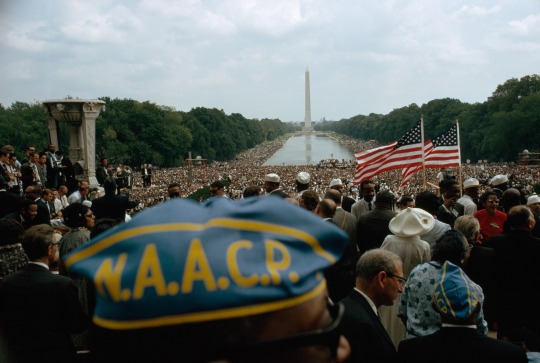
The peaceful crowd of a quarter million people stretched from the Lincoln Memorial, from which the picture is taken, past the reflecting pool to the Washington Monument.
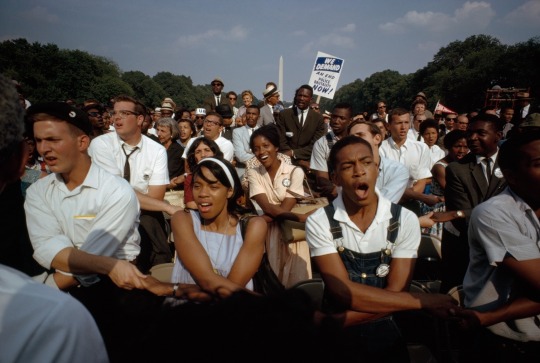
The 1963 March on Washington for Jobs and Freedom gathered together people from civil rights organizations, labor unions, and religious groups across the country to protest segregation, inequality, and economic injustice. As the sign demanding an end to police brutality demonstrates, many of the issues that motivated the marchers remain unresolved.
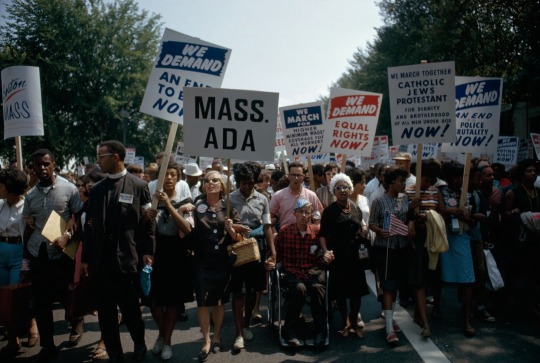
The marchers supported a range of issues that still resonate today, including a higher minimum wage and voting rights. The organizers of the march determined what the signs would say.
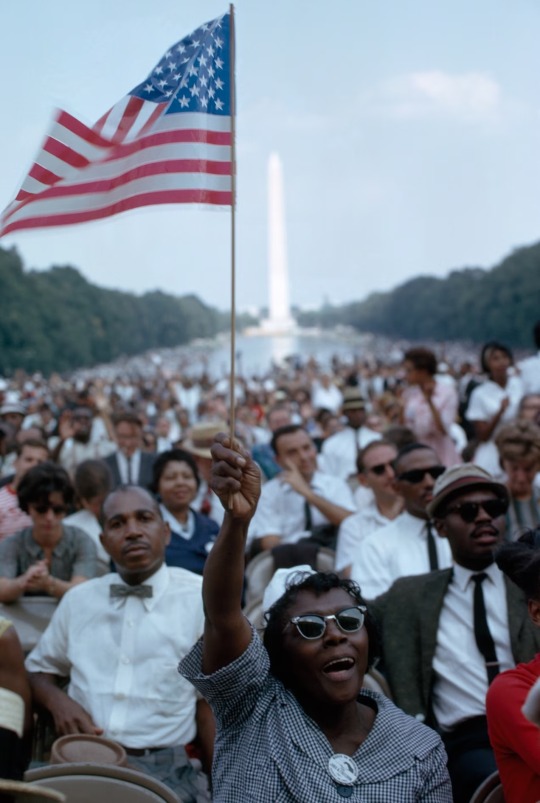
The March on Washington for Jobs and Freedom lasted all day, until shadows from the Lincoln Memorial finally brought relief from the hot August sun.
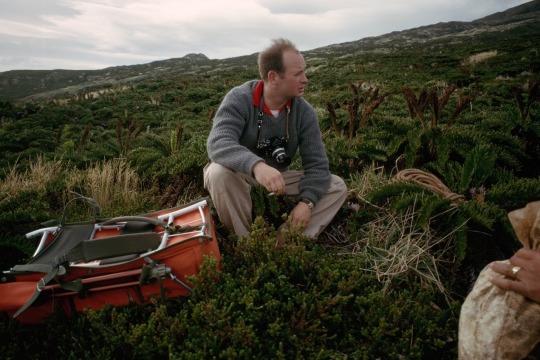
Before James P. Blair photographed the March on Washington, he'd spent six weeks on assignment on the island of Tristan da Cunha in the southern Atlantic. Courtesy National Geographic Image Collection
#Rare Color Photographs#1963 Washington DC March#Dr. Martin Luther King Jr.#Rachel Hartigan#James P. Blair#Washington DC | USA 🇺🇸
0 notes
Text










March on Washington for Jobs and Freedom: The Reverend Martin Luther King, Jr. gives his I Have a Dream speech on August 28, 1963.
#March on Washington for Jobs and Freedom#I Have a Dream speech#Martin Luther King Jr. National Historical Park#Martin Luther King Jr.#Martin Luther King Jr. Center for Nonviolent Social Change#28 August 1963#anniversary#US history#Washington DC#Atlanta#Memphis#Lorraine Motel#Washington Monument#USA#cityscape#tourist attraction#landmark#architecture#civil rights movement#National Mall#Reflecting Pool#original photography#travel#vacation
0 notes
Text

Ivan Massar Joan Baez at the Civil Rights "March on Washington for Jobs and Freedom," Washington DC 1963
428 notes
·
View notes
Text
Thoughts on Netflix's Rustin
I watched Rustin over the weekend. I really liked it Colman Domingo was fantastic and deserves his nominations. The film focuses on the conception and development of the 1963 march on Washington DC and how Bayard Rustin's involvement was downplayed because he was an unashamed gay man. One character is supposedly mostly made up, Rustin's main love interest. I think they did think to give Rustin a black love interest, I don't know if he was interested in black men, but the two known long term partners he had were white. But it also shows what closeted black men of the time went through. There is a white staffer that Rustin has a passing fling with, but he's more into Bayard than Bayard is into him.
Also, there's a portrayal of baby John Lewis
It makes me want to be a low key modern day Rustin. Something to aspire to.
7 notes
·
View notes
Text

paul newman, washington dc, 28, 1963.
civil rights march
martin luther king's 'i have a dream' speech.
6 notes
·
View notes
Text

Congressman Pastor Walter Edward Fauntroy (born February 6, 1933) is the former pastor of the New Bethel Baptist Church in DC and a civil rights activist. He is a former delegate to the House of Representatives and was a candidate for the 1972 and 1976 Democratic presidential nominations as a favorite son as well as a human rights activist. His stated life work is to advocate public policy that “declares Good News to the poor, that binds up the brokenhearted and sets at liberty them that are bound” in the US and around the world.
The fourth of seven children, he was born and raised in DC. His mother, Ethel (Vines) Fauntroy, was a homemaker. His father, William Thomas Fauntroy Sr., was a clerk in the US Patent Office. He graduated second in his class at Washington’s all-black Dunbar High School and the members of his church held fund-raising dinners to provide him with a college scholarship, his church gave him enough money to pay for his first year at Virginia Union University. He pledged Kappa Alpha Psi Fraternity while at Virginia Union, where he graduated with honors and then earned a B.Div. from Yale Divinity School.
During his stay at Virginia Union University, he met the 22-year-old Martin Luther King Jr. With much in common, the two men formed a friendship that began with an all-night discussion of theology. He joined the SCLC and upon his return to DC, became an influential lobbyist for civil rights in Congress. He helped to coordinate the 1963 March on Washington.
He became pastor of the New Bethel Baptist Church. He returned home with an unorthodox view of Christian service that his parishioners immediately embraced. Believing that religion was something more than a Sunday morning ritual, he took part in civil rights demonstrations, sit-ins, and marches – both in DC and elsewhere.
He is married to the former Dorothy Simms and they have two children. #africanhistory365 #africanexcellence #kappaalphapsi
2 notes
·
View notes
Text

GEMINI (AO3). HISTORICAL REFERENCES :)
JOURNALS:
Kay, W. D. “John F. Kennedy and the Two Faces of the U.S. Space Program, 1961-63.” Presidential Studies Quarterly 28, no. 3 (1998): 573-586.
Lantry, Douglas N. “Man in Machine: Apollo-Era Space Suits as Artifacts of Technology and Culture.” Winterthur Portfolio 30, no.4 (1995): 203-230.
Licklider, Roy E. “The Missile Gap Controversy.” Political Science Quarterly 85, no.4 (1970): 600-615.
Michael, Donald N. “The Beginning of the Space Age and American Public Opinion.” The Public Opinion Quarterly, 24, no.4 (1960): 573-582.
Werth, Karsten. “A Surrogate for War: The U.S. Space Program in the 1960s.” Amerikastudien / American Studies 49, no. 4 (2004): 563-587.
GOVERNMENT DOCUMENTS:
Air Force Systems Command. MOL Extravehicular Space Suit Data Book. November 1964.
National Aeronautics and Space Administration. Administrator’s Presentation to the President. March 21, 1961.
National Aeronautics and Space Administration. Gemini 4 Press Kit. Release 65-158. May 21, 1965.
National Aeronautics and Space Administration. Gemini Program Mission Planning Report. No.5019. January 6, 1965.
National Aeronautics and Space Administration. Gemini Program Mission Report: Gemini IV. June 1965.
Transcript of Gemini 4 Mission Commentary. June 3-7, 1965. NASA Headquarters Historical Reference Collection.
ORAL HISTORIES:
Typescript of Oral History Interview with Harold I. Johnson conducted by Peter Vorzimmer. February 10, 1967. NASA Headquarters Historical Reference Collection.
Typescript of Oral History Interview with James McDivitt conducted by Peter Vorzimmer. April 7, 1967. NASA Headquarters Historical Reference Collection.
Typescript of Oral History Interview with James McDivitt conducted by Doug Ward. June 29, 1999. Lyndon B. Johnson Space Center, History Office.
MAGAZINES:
Holmes, Brainerd. “Manned Space Flight.” AIBS Bulletin 12, no. 5 (1962): 56-59.
Kennedy, John F. “If the Soviets Control Space…” Missiles and Rockets, October 10, 1960.
SPEECHES:
Anfuso, Victor L. “Is Space a Way to Peace or War?” Speech, National Secretaries Association, Washington DC, February 16, 1960.
Hilburn, Earl D. Address before the Aerospace Electrical/Electronics Conference. Speech, Los Angeles, California. October 9, 1963.
Kennedy, John F.. “Address at Rice University on the Nation’s Space Effort.” Speech, Rice University, September 12, 1962.
GENERAL:
Anderson, James. “Contraband Corned Beef and the Early Days of Space Biology: The Gemini III Mission.” NASA History. National Aeronautics and Space Administration, March 17, 2022. nasa.gov.
Granath, Bob.. “Gemini IV: Learning to Walk in Space.” NASA History. National Aeronautics and Space Administration, June 5, 2015. nasa.gov.
Grimwood, James M, and Hacker, Barton C. “On the Shoulders of Titans: A History of Project Gemini.” Washington, D.C.: National Aeronautics and Space Administration, Scientific and Technical Information Office, 1977.
NASA Historical Staff, Office of Policy Analysis. “Astronautics and Aeronautics, 1965: Chronology on Science, Technology, and Policy.” NASA SP-4006. Washington, DC: National Aeronautics and Space Administration, Scientific and Technical Information Division, 1966.National Aeronautics and Space Administration.
Project Gemini: Technology and Operations: A Chronology. NASA SP-4002. Washington, DC: National Aeronautics and Space Administration, Scientific and Technical Information Office, 2006.
4 notes
·
View notes
Text
Hidden Herstory: The Leesburg Stockade Girls | National Museum of African American History and Culture
I never fully realized the monumental role that massive numbers of children played in civil rights protests. Law enforcement arrested and jailed children by the thousands for days, and sometimes months, and their involvement helped to enable one of the greatest legal and social assaults on racism in the 20th century—the Civil Rights Act of 1964. The Leesburg Stockade Girls are an incredible example of these courageous, young freedom fighters.
You may ask, “Who were the Leesburg Stockade Girls?” In July of 1963 in Americus, Georgia, fifteen girls were jailed for challenging segregation laws. Ages 12 to 15, these girls had marched from Friendship Baptist Church to the Martin Theater on Forsyth Street. Instead of forming a line to enter from the back alley as was customary, the marchers attempted to purchase tickets at the front entrance. Law enforcement soon arrived and viciously attacked and arrested the girls. Never formally charged, they were jailed in squalid conditions for forty-five days in the Leesburg Stockade, a Civil War era structure situated in the back woods of Leesburg, Georgia. Only twenty miles away, parents had no knowledge of where authorities were holding their children. Nor were parents aware of their inhumane treatment.
A month into their confinement, Danny Lyon, a twenty-one year old photographer for the Student Non-violent Coordinating Committee (SNCC), learned of the girls’ whereabouts and sneaked onto the stockade grounds to take pictures of the girls through barred windows. After SNCC published the photos in its newspaper The Student Voice, African American newspapers across the country printed the story, and the girls’ ordeal soon gained national attention.
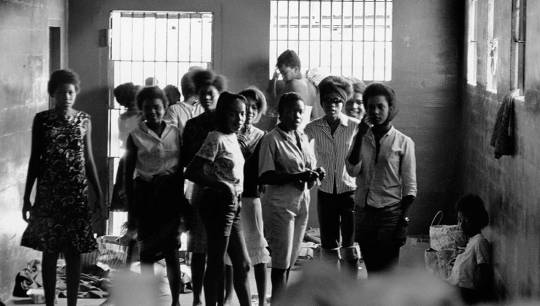
Leesburg, Georgia. Arrested for Demonstrating in Americus, Teenage Girls Are Kept in a Stockade in the Countryside, © Danny Lyon/Magnum Photos, Collection of the Smithsonian National Museum of African American History and Culture.
On August 28, 1963, as Martin Luther King Jr. gave his historic “I Have a Dream” speech in Washington, DC, these children sat in their cell bolstering their courage with freedom songs in solidarity with the thousands of marchers listening to Dr. King’s indelible speech on the National Mall. Soon after the March on Washington, during the same week of the bombing of the five little girls at Sixteenth Street Baptist Church on September 15, 1963, law enforcement released the Leesburg Stockade Girls and returned them to their families.
Their story was part of the broader Civil Rights effort that engaged children in a variety of nonviolent, direct actions. In Alabama, for example, thousands of youth participated in the 1963 Children’s Crusade, a controversial liberation tactic initiated by James Bevel of the Southern Christian Leadership Conference (SCLC) and led by Dr. Martin Luther King, Jr. After careful deliberation about the merit of involving children in street protests and allowing them to be jailed, Dr. King decided that their participation would revive the waning desegregation campaign and would appeal to the moral conscience of the nation.
On May 2, 1963, in response to an invitation from Dr. King, roughly a thousand students—elementary through high school—gathered enthusiastically at Sixteenth Street Baptist Church and joined a civil rights march throughout the streets of Birmingham. By day’s end, law enforcement had jailed over 600 children.
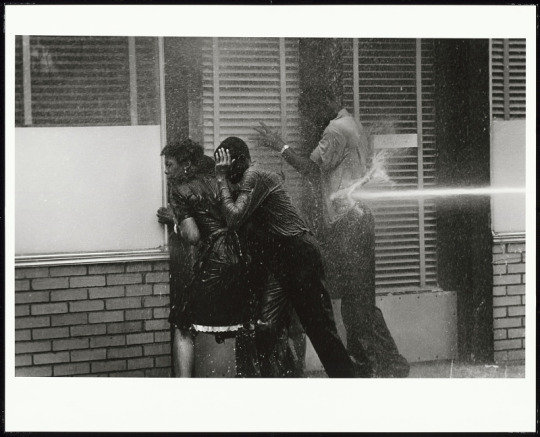
Alabama Fire Department Aims High-Pressure Water Hoses at Civil Rights Demonstrators, © Charles Moore, Collection of the Smithsonian National Museum of African American History and Culture.
The next day the number of children doubled. However, the training classes provided by SCLC leaders could not have prepared the children for the violence they would encounter. The Commissioner of Public Safety Eugene “Bull” Connor directed the use of fire hoses and attack dogs on the children, and people in America and around the world witnessed this brutality. Authorities arrested nearly 2,000 children—one as young as four years old. These protests continued throughout the first week of May, with over 5,000 children being jailed.
Within days, SCLC and local officials reached an agreement, in which the city agreed to repeal the segregation ordinance and release all jailed protestors. Ultimately, the activism of thousands of African American children in 1963, including the Leesburg Stockade Girls, provided the momentum for the March on Washington and contributed to the passage of the Civil Rights Act the following year.
The history of children’s Civil Rights activism continues to be important to tell. The Leesburg Stockade Girls realize this importance, and they are documenting their story. In 2015, as the keynote speaker at a commemorative event for the Leesburg Stockade Girls at Georgia Southwestern State University, I engaged with ten of the surviving women, who shared recollections about the day of their arrest. Remarkably, these women still possess a collective spirit of resistance to social injustice, and they are beginning to embrace their place in history.
As we reflect on their story and the broader history of youth activism, let us consider: How might children today play an equally significant role in promoting racial equality in the United States?
Written by Tulani Salahu-Din, Museum Specialist, National Museum of African American History and Culture.
#The Leesburg Stockade Girls#georgia#lynchburg#white supremacy#badges and incidences of slavery#civil rights activism#adultified#americus georgia#Black Lives Matter#american history#white hate#racisim#Black women
2 notes
·
View notes
Text

•●🍯THE HONEYCOMB🍯●•
✝oday's honey🌱
October 12, 2024
Dr. Martin Luther King, Jr. (1929–1968)
Christian Classics Ethereal Library
🛐📈📈📈📈📈📈📈📈 🛐
Martin Luther King, Jr. was one of the twentieth century’s best-known advocates for nonviolent social change.
Born in Atlanta, Georgia, King’s exceptional oratorical skills and personal courage first attracted national attention in 1955, when he and other civil rights activists were arrested after leading a boycott of a Montgomery, Alabama, transportation company which required nonwhites to surrender their seats to whites, and stand or sit at the back of the bus.
Over the following decade, King wrote, spoke and organized nonviolent protests and mass demonstrations to draw attention to racial discrimination and to demand civil rights legislation to protect the rights of African-Americans.
In 1963, in Birmingham, Alabama, King guided peaceful mass demonstrations that the white police force countered with police dogs and fire hoses, creating a controversy which generated newspaper headlines throughout the world. Subsequent mass demonstrations in many communities culminated in a march that attracted more than 250,000 protestors to Washington, DC, where King delivered his famous, “I have a dream” speech in which he envisioned a world where people were no longer divided by race.
So powerful was the movement he inspired, that Congress enacted the Civil Rights Act in 1964, the same year King himself was honoured with the Nobel Peace Prize. Posthumously awarded the Presidential Medal of Freedom, King is an icon of the civil rights movement. His life and work symbolize the quest for equality and nondiscrimination that lies at the heart of the American—and human—dream.
•°•°•°•°•°•°•°•°•°•°•°•°•°•°•°•°•°•°•°•°•°•°•°•°•°•°•°•°•°•°•°•°•°•°•°•°•°•°•°•°•°•°•°•°•°•°•°•°•°•°•°•°•°•°•°
THE HONEYCOMB©
Bless a life by sharing
https://whatsapp.com/channel/0029Va7eX2L6xCSOeoMRG53p
https://web.facebook.com/honeycombdailydevotional/
https://t.me/thehoneycombdailydevotional
0 notes
Text

Warren K. Leffler, Washington DC, 1963
Cette marche a eu lieu à Washington DC, pour plaider en faveur des droits civiques et économiques des Afro-Américains. On estime qu'environ 250 000 personnes ont assisté à la marche, dont des leaders éminents des droits civiques tels que Martin Luther King Jr., Rosa Parks, Malcolm X et Angela Davis.
0 notes
Text

Faith is a living, daring confidence in God's grace, so sure and certain that a man could stake his life on it a thousand times. (Martin Luther King)
On this day in 1963, Civil Rights leader Dr. Martin Luther King was the central figure and keynote speaker to a crowd numbering a quarter of a million. It was the largest political rally in American history. Although the majority of the crowd were black, there were thousands of white people who marched in solidarity alongside their friends and co-workers. One of them was the powerful union leader, Walter Reuther.
At the conclusion of the ‘March on Washington for Jobs and Freedom’ event, Martin Later King delivered his iconic ‘I Have a Dream’ speech from the steps of the Lincoln Memorial in Washington DC. It has gone down in history as one of the most famous pieces of oratory of all time. The march is credited as having a pivotal influence in the formation of the Civil Rights Act a year later.
“Even though we face the difficulties of today, I have a dream. I have a dream that my four children will one day live in a nation where they will not be judged by the colour of their skin but by the content of their character. I have a dream that one day black boys and black girls will be able to join hands with white boys and white girls as sisters and brothers. I have a dream today” (Martin Luther King - August 28th 1963)
0 notes
Text
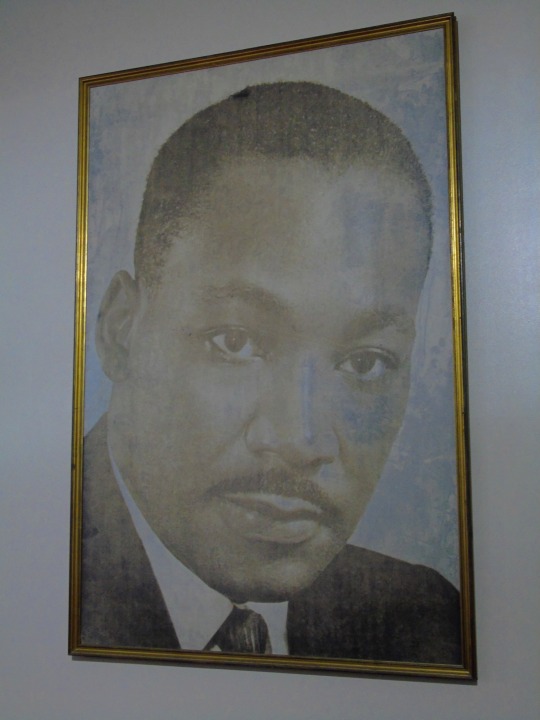



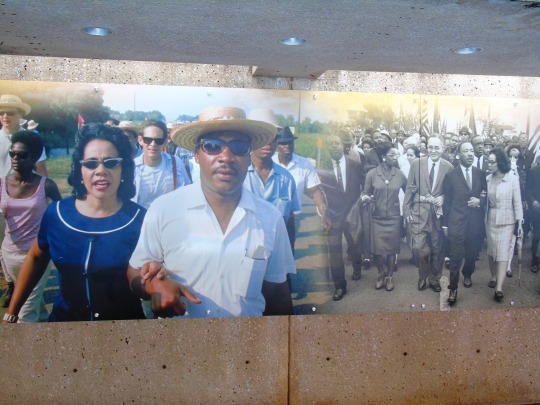





March on Washington for Jobs and Freedom: The Reverend Martin Luther King, Jr. gives his I Have a Dream speech on August 28, 1963.
#March on Washington for Jobs and Freedom#I Have a Dream speech#Martin Luther King Jr. National Historical Park#Martin Luther King Jr.#Martin Luther King Jr. Center for Nonviolent Social Change#28 August 1963#60th anniversary#US history#summer 2016#2009#Washington DC#Atlanta#Memphis#Lorraine Motel#Washington Monument#USA#cityscape#tourist attraction#landmark#architecture#civil rights movement#National Mall#Reflecting Pool#original photography
0 notes
Text
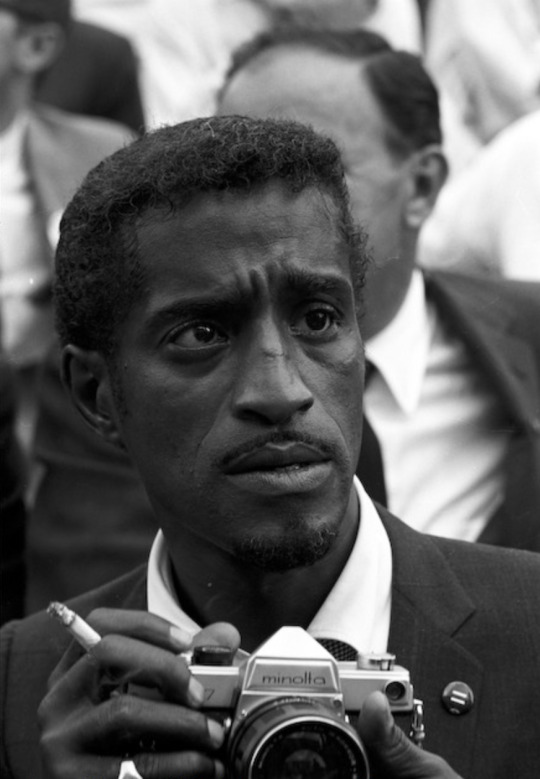
Ivan Massar Sammy Davis, Jr at the Civil Rights "March on Washington for Jobs and Freedom," Washington DC 1963
377 notes
·
View notes
Text
instagram
Last week's Crossflix film was "Rustin", and with Pastor Bridie on vacation, Rev. Hannah and Pastor Devon had to get creative with the altar design. The signs on the altar are images of original protest signs held in the 1963 March on Washington DC.
.
.
.
Crossflix2024 #Rustin #Crossflix #FindingFaithInFilm #InPersonChurch #onlinechurch #sundayservice #hollywood #HollywoodUMC #Community #HUMC #Sunday #church #Ministry #Inclusivechurch #affirmingchurch #churchfamily #AllAreWelcome
0 notes
Text
Throwback Thursdays

Today I drew Dr. Martin Luther King Jr. And today I'm going to talk about Detroit walk to freedom.It happened in June 23rd in 1963 in Detroit, Michigan. It was a massive march during the Civil Rights Movement, there were 125,000 participants and spectators present, which made it the LARGEST Civil Rights demonstration in the nation's history prior to the March on Washington in Washington DC in August 1963. The March was organized by Rev. Clarence LaVaughn Franklin (He was the father of Aretha Franklin and Rev. Albert B. Cleage) Franklin and Cleage as well as other organizers for the Detroit Council for Human Rights have planned the march. Cleage wanted the march to be all Black and led by Black people only but National Association for the Advancement for Colored People basically were like 'Hey umm we're going to boycott the march if you didn't include white leaders into the march' so of course Cleage changed his mind. The March had 3 goals, to speak out against the segregation and the brutality they experienced regularly in the South, addressed concerns in the urban North that included employment and housing discrimination and de facto school segregation. The March was intended to raise funds and awareness for the Southern Christian Leadership Conference. Coincidentally at that day was also the 20th anniversary of the Detroit Race Riot. So the majority of the marchers were Black, but there were also white participants such as Michigan governor John Swainson, Detroit mayor Jerome Cavanagh,the president of the United Auto Workers, Walter Reuther and Billie S. Farnum. George Romney was unable to attend because he needed to attend the service of the Church of Latter Day Saints.The march started around 3 p.m. on both Woodward Avenue and Adelaide and it continued along Jefferson and it concluded at Cobo Arena and Hall, the song 'The Battle Hymn of the Republic' was sung during the march and people carried banners and signs. The march lasted about 90 minutes and was highlighted by a speech from you guessed it Dr. Martin Luther King Jr. which was 'I Have a Dream' . There were also other speakers included such as Charles Diggs, Cleage, Reuther and Swainson. And 20,000 people in 2013 celebrated the 50th anniversary of the march including Martin Luther King lll,Dave Bing,Jesse Jackson and Al Sharpton.
Source :
0 notes
Text

The March on Washington for Jobs and Freedom, the March on Washington, or The Great March on Washington, was held in DC on Wednesday, August 28, 1963. The purpose of the march was to advocate for the civil and economic rights of African Americans. Martin Luther King Jr., standing in front of the Lincoln Memorial, delivered his historic “I Have a Dream” speech in which he called for an end to racism.
The March was organized by A. Philip Randolph and Bayard Rustin, who built an alliance of civil rights, labor, and religious organizations that came together under the banner of “jobs and freedom.” Estimates of the number of participants varied from 200,000 to 300,000; the most cited estimate is 250,000 people. Observers estimated that 75–80% of the marchers were African American. The March was one of the largest political rallies for human rights in US history.
The march is credited with helping to pass the Civil Rights Act of 1964 and preceded the Selma Voting Rights Movement which led to the passage of the Voting Rights Act of 1965.
The speech given by SCLC president King, who spoke last, became known as the “I Have a Dream” speech, which was carried live by TV stations and subsequently considered the most impressive moment of the March. In it, King called for an end to racism in the US. It invoked the Declaration of Independence, the Emancipation Proclamation, and the US Constitution. At the end of the speech, Mahalia Jackson shouted from the crowd, “Tell them about the dream, Martin!”, and King departed from his prepared text for a partly improvised peroration on the theme of “I have a dream”. Over time it has been hailed as a masterpiece of rhetoric, added to the National Recording Registry, and memorialized by the National Park Service with an inscription on the spot where King stood to deliver the speech. #africanhistory365 #africanexcellence
0 notes